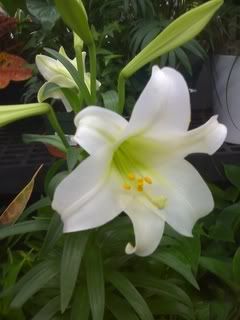
Select a plant that has unopened flower buds on the way. If they are all already open, the plant may be nearly finished blooming. Once you have the plant at home you can carefully remove the yellow anthers inside the open flowers. These are the pollen-bearing parts of the stamen and can get very messy. Lily pollen will stain everything it touches, so be careful. Removal of the anthers will extend the life of the flowers, especially if done right after the flower opens and before the pollen begins to shed.
Keep your lily somewhere cool. Lower temperatures will decrease the speed at which the flowers open and also the rate at which they senesce, or fall off. Daytime temperatures in the low 60’s are best, with a slightly lower temperature at night. Don’t place the plant near a drafty window for cool air as it may cause the flowers to fall off. A place somewhat away from the window is good, especially if it provides bright but diffuse light.
Be careful not to over-water your Easter Lily. As with all bulbs, too much water can be lethal. Make sure there are holes in the bottom of the pot and never let the plant sit in water.
These lilies, like most, are considered to be extremely toxic to cats. The ASPCA lists as symptoms of lily ingestion by cats: vomiting, lethargy, loss of appetite, kidney failure, and ultimately death. Easter Lilies are not considered toxic to other species, though eating them is not advised.
Easter Lilies can’t grow and bloom indefinitely indoors. They need an extended cool season to prompt next year’s flowering which is best provided naturally outdoors. When the plant has finished its show for the year, continue to care for it indoors until the local frost-free date has passed. The lily can then be transplanted into the ground and enjoyed as an outdoor plant. The “Nellie White” variety is hardy to about Zone 5.


